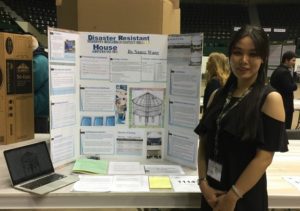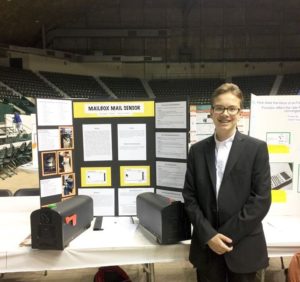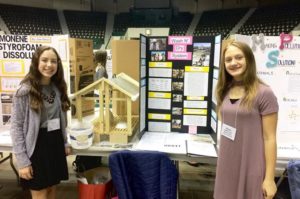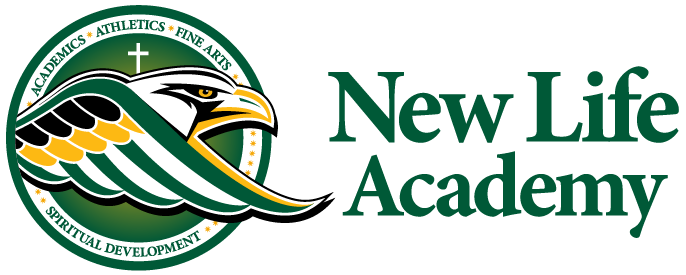Congratulations to Nancy, Nicolas, Bryna and Noelle for earning Blue Ribbons (highest level of excellence) on their 15% IP Projects at the Twin Cities Regional Science/Engineering Fair. Read about their creative and innovative ideas below.
Nancy’s Project is a Disaster Resistant House and has been invited to compete at State and received the Arizona State University Walton Sustainability award.
- Blue Ribbon – The highest score in High School Environmental Engineering Category
- Purple Ribbon – Advanced to the State Science and Engineering Competition
- Recipient of the Arizona States University Sustainability Solutions Award
Hurricane Maria hit Puerto Rico in 2017 and damaged a lot of homes, putting many lives at risk. After seeing images and reports of the devastations caused by this disaster, I decided to design the model of a hurricane resistant house that can tolerate strong wind and flood pressures in vulnerable areas near the coasts. My model is made up of concrete and includes thick pillars at the base and a cone-shaped roof. The round shape of the building helps resist wind pressure and the pillars allow water to pass through during a flood surge. The concrete formula is a mixture of aggregates and cement which can be prepared by recycling materials from the damaged buildings. This method could speed up removal of debris and help clean up pollution and save money. I built the prototype by pouring the concrete into a cardboard mold and attached five PVC pillars to the base. Next, I installed the prototype into a large tray containing black soil, grass and gravel, similar to the local land composition. The stability of the model against water pressure is recorded at various distances from the house. I used a wind-blower at different speeds to test the effects of wind pressure. The house stayed stable at the applied wind and water pressures in my initial testing. In the future, I like to compare the stability of my model’s round walls with a traditional wall shape against stronger wind and water pressures.

Nicolas’ Project is a Mailbox Mail Sensor and has been invited to compete at State and has been invited to the National Broadcom Masters Competition.
- Blue Ribbon – The highest score in Middle School Embedded Systems Category
- Purple Ribbon – Advanced to the State Science and Engineering Competition
- Top 10% – Qualified for the National Broadcom Masters Competition
The purpose of my project is to design a lighting system above a mailbox that will notify a homeowner if their mail has arrived, by the time they would get home. I think that this is an important and helpful addition to the mailbox, so people can know immediately if they should stop to collect their mail. My engineering goal is to create different concepts on how to get a light to be triggered on the top of a mailbox when mail has arrived. First, I brainstormed ideas for technical feasibility. Then, I built several prototypes of the best solution concepts. Finally, I tested them with adding different amounts of paper to represent mail at different temperatures. The variation in outdoor temperatures during different seasons can affect the accuracy and reliability of the sensors. My project will look at multiple ways to detect either mail or mail delivery to a mailbox. Prototype testing will determine the best design for this system. I know that most homeowners will benefit from this awesome new notification system. I plan to make improvements and add other features, such as using solar energy to power the light, in the future.

Noelle and Bryna’s Project is a Wash N’ Dry System and received the highest level of excellence Blue Ribbon.
- Award: Blue Ribbon – The highest score in Middle School Environmental Engineering Category
Last year, Noelle went on a mission’s trip to Haiti. This sparked the idea of our Wash N’ Dry System. She noticed that some Haitians living in rural areas put their used dishes on the ground after washing them in dirty rivers, which would make them unsanitary. To address this problem, we decided to build a unit that collects rain water, rinses and dries the dishes away from dirt. Our design solution would make dishes cleaner and decrease the rate of food and water-borne diseases. Our Wash N’ Dry System consists of a drying rack with a roof and two gutters that lead rainwater towards a bucket. We first tested our system’s construction quality by pouring water onto the roof and checked for leakage. Next, we poured different amounts of water on the top and measured the volume in the bucket to test the efficiency of water collection. Almost all added water dripped in the bucket. In the future, we plan to test our system outdoors in the summer, after several rainfalls, when the temperatures are similar to Haiti. We expect some water loss due to evaporation. We will apply different substances on the plates and measure the minimum amount of water needed to fully clean the dishes. Our future plans include water quality testing after a rain and installing additional components, such as automatic detergent dispensers and scrubbers, to improve the functions of our invention.

